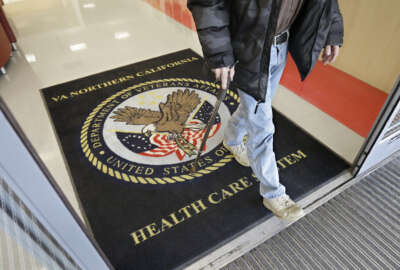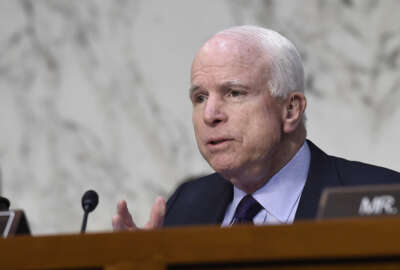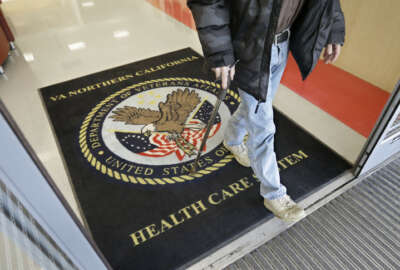
As VA privatization debate heats up, federal union, VSOs back agency’s mission
The Veterans Affairs Department says it’s earning back trust and confidence from the veterans it serves, and employee engagement within the department is also...
The Veterans Affairs Department says it’s beginning to earn back the trust and confidence of the veterans it serves — and its own employees — at a pivotal time for the agency’s future.
“This is a new VA,” Undersecretary for Health David Shulkin said June 21 at a joint Roosevelt Institute and Union Veterans Council conference in Washington. “We recognize, particularly coming out of this crisis, that we can’t do this alone. As much as we want to do everything and meet all the needs of veterans, we need the country’s help. We need to be working with community providers in the right way.”
The debate over the “right way” is picking up steam now as Congress, the VA and veterans service organizations discuss what role the department will play in veterans health care into the next administration and well into the future.
The American Federation of Government Employees, which represents roughly 230,000 VA employees, and with several veterans service organizations joined the VA in calling for support and partnership from the private sector to help the department meet its mission.
“We do not think the VA is broken beyond repair as some have said,” Garry Augustine, executive director of Disabled American Veterans (DAV) service and legislative headquarters, said. “Many of the stories that are out there are dated stories. The VA is doing some very positive things working with VSO partners. [They’re] more receptive to our ideas than any time in my 28 years.”
VA’s self-reported “trust and confidence score” rose from 47 at the end of fiscal 2015 to 57.5 at the end of the first two quarters of 2016, Shulkin said.
VA also earned noticeably higher employee engagement scores — from 267 points in 2015 to 313 points now.
Employees also indicated higher satisfaction so far this year on nearly every individual aspect of engagement.
“There’s beginning to be some positive results as we do our employee engagement survey,” Shulkin said. “[It’s] not enough, not fast enough, but we are beginning to see some movement in the right direction as we see big changes in employee input, innovation, senior leader ethics and information. It’s encouraging. Certainly we have a lot more work to do.”
The scores for employee engagement are based on survey responses from VA central office employees, as well as feedback the department collects from the Federal Employee Viewpoint Survey, Shulkin told Federal News Radio. The trust and confidence scores also come from surveys the VA provides to its patients.
VA is also beginning to fill several top seats at the department’s medical centers. A few months ago, VA told Congress it has 35 leadership vacancies at its hospitals across the country.
“It’s very hard to create change and have stability in an organization without a leader,” Shulkin said. “Today, we’ve just named 28 people selected, 28 medical center directors out of those 35.”
VA is still looking for 13 more directors, as six more of its medical center leaders are planning to retire this year, he said.
Shulkin’s comments come roughly 10 days before the VA Commission on Care is expected to submit its final report on the department’s health care systems and organizational structure to Congress and President Barack Obama.
According to the draft report, the congressionally-appointed, 15-member commission will suggest a major overhaul to the Veterans Health Administration’s personnel system, as well as several options to gradually shift more health care options from VA medical centers to private community providers.
The Senate VA Committee passed its omnibus, the Veterans First Act, which cleared the committee without amendment last month. The Senate as a whole has yet to take up the bill, which addresses some, but not all, of the congressional authorities for which the department has spent much of the last year asking.
Sen. John McCain (R-Ariz.) introduced a bill last month that would make the current Veterans Choice Program permanent. The Care Veterans Deserve Act would also let all qualified veterans use the Choice card to receive care from community providers if they choose, regardless of where they live.
Related Stories
Several veterans service organizations say they’re concerned that private providers lack the same knowledge that VA providers have of veterans health issues and their combat history. They generally agreed most private providers take a different approach to mental health, which the VA incorporates in every aspect of its care.
“They have real concerns about for-profit, private medical care,” said Joshua Ulibarri, partner at Lake Research Partners, a public opinion research firm. “They have real concerns about pushing veterans into that system. They have concerns that the way veterans will be cared for, the unique experiences veterans have, can’t be cared for adequately in for-profit insurance and that they’ll find ways to cut corners.”
Bill Rausch, executive director of Got Your 6 and a veteran himself, said the answer isn’t one or the other — only the VA or only private care.
“Ultimately, what we need is a system that supports the veteran and their family, which involves both, and it already does,” he said.
VA Committee Chairman Johnny Isakson said he had no interest in trying to privatize the VA. But his committee is trying to determine what the right blend of VA and community care options will look like, he said at a hearing last month.
The current Choice Program, which lets veterans who live more than 40 miles away from a VA hospital or have waited for an appointment receive health care from a private provider, will expire next summer without congressional action.
Shulkin said he’s optimistic Congress will find and pass an agreement.
“Congress understands that we do need legislation to make care in the community simpler and to make it work better for veterans,” he told Federal News Radio. “I do understand that this takes time, but I have every confidence that our legislature will do the right thing for veterans.”
Copyright © 2024 Federal News Network. All rights reserved. This website is not intended for users located within the European Economic Area.
Nicole Ogrysko is a reporter for Federal News Network focusing on the federal workforce and federal pay and benefits.
Follow @nogryskoWFED





